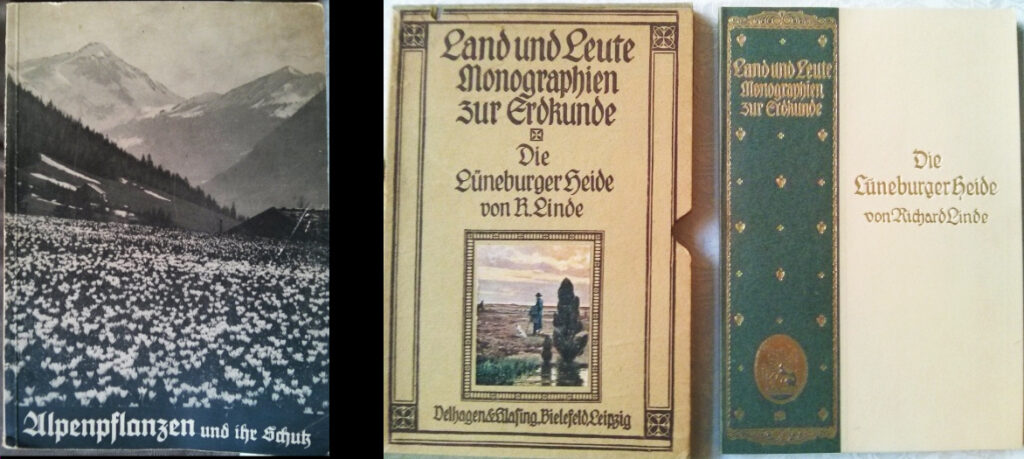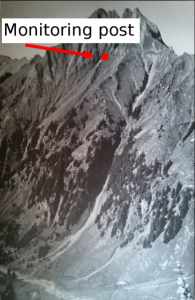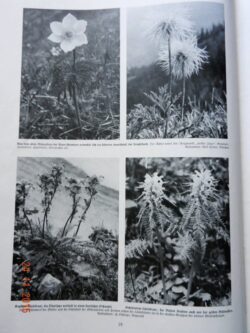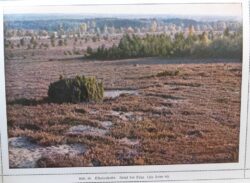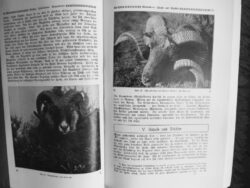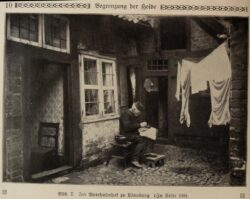Two remarkable finds from a flea market last week are fascinating evidence of how the interactions between people and nature were recognized very early on in Germany, at least in comparison to other Western cultures including the United States, despite its early accomplishments in nature protection. (Interesting, this recognition is meagre in Germany nowadays but that’s beyond our scope here.) These are two books for popular audiences, from 1921 and 1939, that combine ecology, geography, botany and cultural history in a way that, to the best of my knowledge, didn’t appear in the U.S. until some decades later.
For millenia, the Germans’ relationship to the natural world has been considered especially noteworthy and fascinating. The ancient Romans admired what they saw as the arcadian vigor of the German tribes living in close contact with nature, in contrast to Rome’s weak decadance. In the nineteenth century, Germans were the originators – among Western cultures – of outdoor recreation and exercise, spiritual contact with nature, vegetarianism, and related practices. Also around that time, a German coined the word “ecology” and Germany was arguably birthplace of the field. In the Third Reich, some of the worst cruelty in human history was closely tied to the Germans’ conviction that their superiority was inseperable from the landscape itself, under the slogan “blood and soil”.
Many shelves-worth of books have examined this history. Here we will have a rare first-hand glimpse at some German writings on nature from the era of National Socialism. I can confirm that, as far as I can tell, the books are essentially just about documentation and nature conservation. I have been unable to find blood-and-soil messages in the books, either direct or implied. Perhaps I’m just not looking hard enough. But I am honestly not seeing anything nearly as politically charged as some of the language used today in the U.S. when talking about non-native invasive species, which can have harshly xenophobic tones (although I unconditionally support the protection of native biodiversity).
Alpenpflanzen und ihr Schutz (Alpine Plants and their Protection) from 1939 is about some of the most beloved and endangered Alpine landscapes and plant species and efforts to preserve them.
It describes how, starting in the 1920s, laws were passed, and environmental organizations raised awareness, for the protection of plants that were becoming endangered due to commercial and amateur collecting and hikers’ foot traffic. When the laws weren’t enforced, the organizations partnered with a mountain-rescue organization which had observation posts on mountaintops in climbing areas to watch for accidents, and got them to also act as plant-poaching monitors.
I’m curious what about what kind of poaching was taking place. If it was local subsistence farmers collecting wild plants on lands they have always had access to, then that raises questions about reconciling their livelihoods with nature conservation.
In the U.S., the history of the environmental movement customarily focuses on birds and large animals, and on milestones such as Theodore Roosevelt’s efforts and the founding of the Audubon Society around the turn of the century. Whether there was widespread popular interest in endangered plants before, for example, Rachel Carson’s Silent Spring, including books like these for popular audiences, I’m honestly not sure.
Also fascinating in Alpenpflanzen is the discussion of how the plant populations recovered during World Word One because tourism and the plant trade were sharply reduced, and then they declined again after the war. In ecology this is now called a ‘natural experiment’, where natural conditions create a sort of experiment that would be impossible for scientists to conduct due to size and cost. Again, this is pretty sophisticated for a popular publication in 1939.
The second book is Die Lüneburger Heide (Lüneburg Heath) from 1921, in the series Land und Leute – Monographien zur Erdkunde (Land and People – Geography Monographs).
Lüneburg Heath is one of the few remaining areas of this landscape type that was once widespread. The book focuses on the flora, fauna, land use, geology, topography and climate but also includes history, human geography, folklore and agriculture – a holistic, integrative assemblage that in the anglophonic scholarly world only appeared in the 1980s under the rubric ‘interdisciplinary’. The series has 29 volumes on different regions. Soon, through the 1920s, the appreciation of local nature and cultural traditions would mutate into grotesque nationalistic hysteria leading to fascism, or perhaps the seeds were always there, lying dormant. Today, of course, we can see the distinction between valuing local social and cultural traditions, and believing those traditions and peoples are the only good ones and everything else is to be exterminated.
